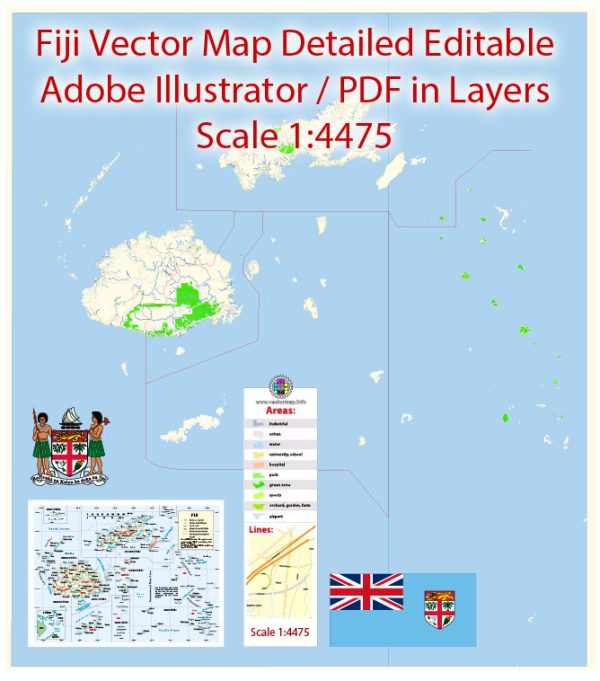Fiji is an island nation located in the South Pacific Ocean. It is situated in the Melanesian region, approximately 1,100 miles (1,770 kilometers) northeast of New Zealand. Fiji is composed of more than 300 islands, of which around 110 are permanently inhabited. These islands are spread out over an area of approximately 18,300 square kilometers (7,100 square miles).
Here’s a more detailed geographical description of Fiji:
- Islands: Fiji’s two main islands are Viti Levu and Vanua Levu. Viti Levu is the largest and the most populous, housing the capital city, Suva, and the majority of the country’s population. Vanua Levu is the second-largest island. Other significant islands in Fiji include Taveuni, Ovalau, Kadavu, and the Yasawa and Mamanuca island groups.
- Terrain: Fiji’s landscape is characterized by lush, tropical vegetation, volcanic mountains, and beautiful beaches. The interior of Viti Levu contains mountain ranges, with the highest peak, Mount Tomanivi (formerly Mount Victoria), reaching an elevation of 1,324 meters (4,344 feet). The islands are surrounded by coral reefs, making it a popular destination for snorkeling and diving.
- Climate: Fiji has a tropical maritime climate with warm temperatures throughout the year. The wet season typically occurs from November to April, during which the islands experience heavy rainfall and the possibility of cyclones. The dry season runs from May to October, offering milder weather with less rainfall.
- Flora and Fauna: Fiji’s diverse ecosystems are home to a wide variety of plant and animal species. The islands boast a range of tropical rainforests, mangroves, and coral reefs. Wildlife includes a mix of indigenous and introduced species, such as birds, reptiles, marine life, and endemic flora.
- Geography: The country is part of the Pacific Ring of Fire, which means it’s located in an area prone to volcanic and seismic activity. Earthquakes and volcanic eruptions occasionally occur, shaping the islands’ geology and topography.
- Coastal Areas: Fiji’s coastline is characterized by numerous bays, coves, and sandy beaches, making it a popular destination for water sports and tourism. The crystal-clear waters surrounding the islands are rich in marine life, including colorful coral formations and a variety of fish species.
- Natural Resources: Fiji’s geographical features provide resources like timber, fisheries, and minerals. Tourism is a significant part of the country’s economy, as the pristine natural environment and vibrant culture attract visitors from around the world.
Fiji’s stunning natural beauty, friendly people, and vibrant culture make it a popular destination for tourists and a unique place to explore in the South Pacific.


 Author: Kirill Shrayber, Ph.D.
Author: Kirill Shrayber, Ph.D.